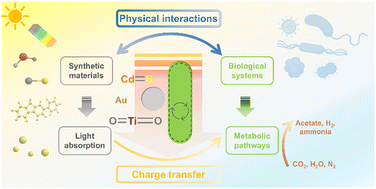Making the connections: physical and electric interactions in biohybrid photosynthetic systems
Abstract
Biohybrid photosynthesis systems, which combine biological and non-biological materials, have attracted recent interest in solar-to-chemical energy conversion. However, the solar efficiencies of such systems remain low, despite advances in both artificial photosynthesis and synthetic biology. Here we discuss the potential of conjugated organic materials as photosensitisers for biological hybrid systems compared to traditional inorganic semiconductors. Organic materials offer the ability to tune both photophysical properties and the specific physicochemical interactions between the photosensitiser and biological cells, thus improving stability and charge transfer. We highlight the state-of-the-art and opportunities for new approaches in designing new biohybrid systems. This perspective also summarises the current understanding of the underlying electron transport process and highlights the research areas that need to be pursued to underpin the development of hybrid photosynthesis systems.

- This article is part of the themed collection: Recent Open Access Articles


 Please wait while we load your content...
Please wait while we load your content...